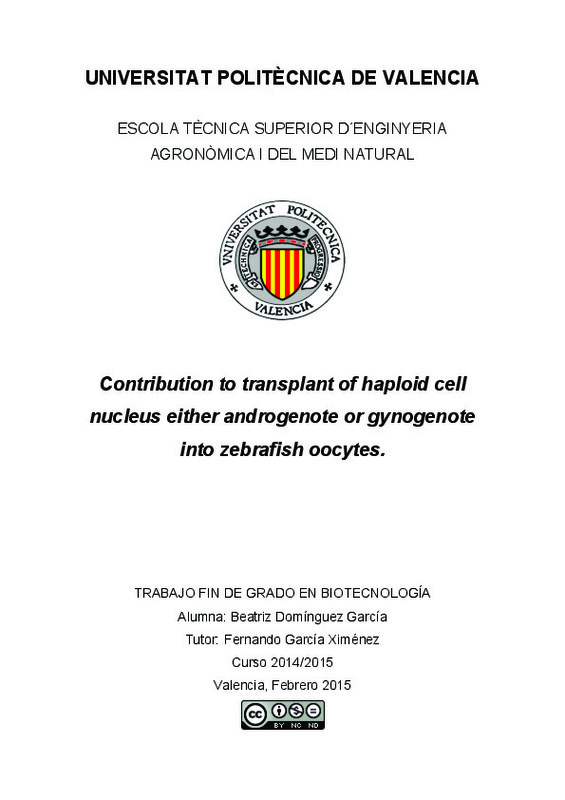JavaScript is disabled for your browser. Some features of this site may not work without it.
Buscar en RiuNet
Listar
Mi cuenta
Estadísticas
Ayuda RiuNet
Admin. UPV
Contribution to transplant of haploid cel nucleus either androgenote or gynogenote into zebrafish oocytes
Mostrar el registro sencillo del ítem
Ficheros en el ítem
| dc.contributor.advisor | García Ximenez, Fernando
|
es_ES |
| dc.contributor.author | Domínguez García, Beatriz
|
es_ES |
| dc.date.accessioned | 2015-07-16T13:43:56Z | |
| dc.date.available | 2015-07-16T13:43:56Z | |
| dc.date.created | 2015-03-06 | |
| dc.date.issued | 2015-07-16 | es_ES |
| dc.identifier.uri | http://hdl.handle.net/10251/53323 | |
| dc.description.abstract | [EN] The existence of the imprinting mechanism in zebrafish may be useful for studying the role this same phenomenon has in mammals. To try to figure out how the imprinting occurs in zebrafish, androgenote and gynogenote haploid larvae are built. Gynogenote haploid larvae are produced by fertilization of oocytes with UV light irradiated spermatozoa, and androgenote haploid larvae by UV light irradiated oocyte fertilized with sperm. Differences in the obtaining of these larvae are noted and the effectiveness of the applied radiation may be analyze. With the haploid larvae that survive after 24 hours and diploid larvae, cell cultures were performed. Using cultures derived from such larvae, somatic cell nuclear transplant experiments make it possible to assess the capacity of the oocyte to reprogram the nucleus from somatic haploid cells from already differentiated larvae. | es_ES |
| dc.description.abstract | [ES] La existencia del mecanismo de imprinting en pez cebra puede ser útil para estudiar el papel que cumple este mismo fenómeno en mamíferos. Para intentar averiguar cómo tiene lugar el imprinting en el pez cebra, se construyen larvas haploides ginogenotas y androgenotas. Las larvas haploides ginogenotas se producen por fertilización de ovocitos con espermatozoides radiados con luz UV, y las larvas haploides androgenotas por fertilización de ovocitos radiados con luz UV con espermatozoides. Se observan diferencias en la obtención de estas larvas y se podrá analizar la eficacia de la radiación aplicada. Con las larvas haploides que sobrevivan tras 24 horas y con larvas diploides se realizan cultivos celulares. El uso de los cultivos derivados de tales larvas en experimentos de transplante nuclear de células somáticas, permitirá evaluar mejor la capacidad del ovocito para reprogramar el núcleo de células somáticas haploides procedentes de larvas ya diferenciadas. | es_ES |
| dc.language | Inglés | es_ES |
| dc.publisher | Universitat Politècnica de València | es_ES |
| dc.rights | Reconocimiento - No comercial - Sin obra derivada (by-nc-nd) | es_ES |
| dc.subject | Cel culture | es_ES |
| dc.subject | Haploid | es_ES |
| dc.subject | Nuclear transplant | es_ES |
| dc.subject | Reprogramming | es_ES |
| dc.subject | Zebrafish | es_ES |
| dc.subject | Cultivo celular | es_ES |
| dc.subject | Haploide | es_ES |
| dc.subject | Transplante nuclear | es_ES |
| dc.subject | Reprogramación | es_ES |
| dc.subject | Pez cebra | es_ES |
| dc.subject.classification | PRODUCCION ANIMAL | es_ES |
| dc.subject.other | Grado en Biotecnología-Grau en Biotecnologia | es_ES |
| dc.title | Contribution to transplant of haploid cel nucleus either androgenote or gynogenote into zebrafish oocytes | es_ES |
| dc.type | Proyecto/Trabajo fin de carrera/grado | es_ES |
| dc.rights.accessRights | Abierto | es_ES |
| dc.contributor.affiliation | Universitat Politècnica de València. Departamento de Ciencia Animal - Departament de Ciència Animal | es_ES |
| dc.contributor.affiliation | Universitat Politècnica de València. Escuela Técnica Superior de Ingeniería Agronómica y del Medio Natural - Escola Tècnica Superior d'Enginyeria Agronòmica i del Medi Natural | es_ES |
| dc.description.bibliographicCitation | Domínguez García, B. (2015). Contribution to transplant of haploid cel nucleus either androgenote or gynogenote into zebrafish oocytes. http://hdl.handle.net/10251/53323. | es_ES |
| dc.description.accrualMethod | TFGM | es_ES |
| dc.relation.pasarela | TFGM\23001 | es_ES |
Este ítem aparece en la(s) siguiente(s) colección(ones)
-
ETSIAMN - Trabajos académicos [3541]
Escuela Técnica Superior de Ingeniería Agronómica y del Medio Natural






